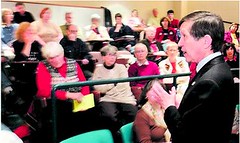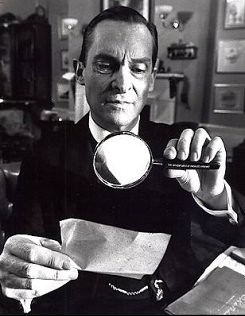Quaker high school graduation; Kaplan's Wittgenstein meme
This weekend, Hilary and I went to her sister’s graduation from the Meeting School, a nominally Quaker private high school in the rural town of Rindge, New Hampshire. The graduation was held in a small barn, open on each end, allowing breezes and birds to circulate freely, with wildflowers decorating the lofts and beautiful natural light unevenly illuminating the rough wood. How nice to get to go to school in such a place! I thought, someplace without lockers and hallways and bells and desks in rows, without all the architectural forms of bodily control that, along with everything else that’s coercive and hierarchically mediated about public school, constitute teenagers as a political and intellectural minors.
Before I go any further: the Wittgenstein meme. Background: Mark Kaplan of Charlotte St. has recently shared with his readers comments he wrote in margins of Wittgenstein’s Culture and Value. The meme is: share marginal notes from your Wittgenstein books, and no fair making up new ones. (My favorite kind of marginal note is “No!”, but I’m not finding any. (Not because I didn’t feel it.)) My own Wittgenstein notes are pretty disappointing, but I’ll quote a passage from Culture and Value that I remembered during my visit to the Meeting School, the reigning atmosphere and moral gestalt of which I found myself resisting in several ways, one of which this passage articulates. The only note I made on this passage is a correction of the translation’s rendering of Straßen as “trees” rather than “streets,” which is presumably not due to a flaw Peter Winch’s German but just an anagrammatical slip.
It is very remarkable that we should be inclined to think of civilization—houses, streets, cars, etc.—as separating man from his origins, from what is lofty and eternal, etc. Our civilized environment, along with its trees [rendering Bäume this time] and plants, strikes us as though it were cheaply wrapped in cellophane and isolated from everything great, from God as it were. That is a remarkable picture that intrudes on us.Return to main text: The Meeting School is a functioning organic farm, with crops and livestock, and the students do farm chores and learn about farming. Aside from this, students are allowed maximal intellectual freedom, though of a quite particular sort. Let us say that this sort of freedom is not won from a dialectical struggle with external forces that attempt to shape one’s education. It is the freedom to drift in voids of one’s choosing, where the fiction of spontaneous curiosity and creation from within is elevated to an ethical precept, and negation by one’s hierarchic betters is scrupulously withheld.
Now, wherever “self-directed” secondary education may or may not lead, it probably feels better and more human than whatever it is that US public schools provide. Maybe you won’t learn what a function is, or how DNA replicates, or whatever, but so what, if you get to feel like a person more or less full-time. Your brain will probably mature enough on its own while you’re mucking out the stalls or reading Stephen King—for if you are social and well-fed and untwisted by fear, your brain’s development is pretty much unstoppable—so you’ll be able to pick up later whatever you need to know. (P.S.: It costs a lot of money to get to feel like a person more or less full-time.)
Part of the graduation program was a truncated Quaker service. This form of worship involves sitting in silence for a specified period (in this case, 40 minutes) and going wherever it is that one’s mind goes—toward the Light, Quakers believe—when everything else is suspended for a time. If moved by some inner event, a participant may stand and speak. The speaker might offer a simile addressing some aspect of life or love, or draw a connection between a seemingly quotidian event in his or her life and a more abstract meaning illustrated by it. Such interruptions are usually infrequent, thereby allowing worshippers to fully absorb the statement into their trance before being disturbed by the next speaker.
I quite enjoyed the state of mind I cultivated in the relative silence, which silence was suitably imperfect, textured by birds flying through the barn, roosters wandering outside and calling out, and occasional cars passing on the road—elements easily synthesized in the course of my meditation. However, verbal interruptions damaging to the Quaker trance became increasingly frequent as parents—mostly dads—began to feel it was OK to use this time to say how proud they were of their child, etc. But as this was primarily a graduation and not an event staged for my own spiritual benefit—though I believe it did benefit me spiritually—I wasn’t too bothered by the interruptions.
In other news, I’ve made it through the next 50 pages of Gravity’s Rainbow, so, according to my contract with John, another report is due. I cannot deliver now, though I’ll say that I’m enjoying the book way more than I expected to. I am engrossed in comprehension; interpretation of a more abstract sort must wait.



